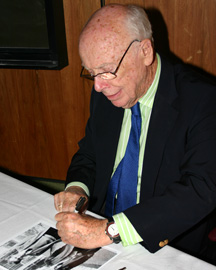

Tales from a Life in DNA
By Mika Ono
A living legend spoke at The Scripps Research Institute's La Jolla campus on September 24—James Watson, who with his colleague the late Sir Francis Crick, discovered the structure of DNA. Now 79, Watson gave the audience what he said he likes in a lecture—a challenge to think about things in a new way.
In introducing Watson, Scripps Research Dean of the Faculty Gerald Joyce noted that Watson was on tour to promote his new book, Avoid Boring People (Lessons from a Life in Science). "This book is not politically correct or even socially correct," said Joyce. "It presents an unvarnished view of life in science."
And, in his talk to the packed auditorium of Scripps Research scientists, staff, and students, Watson gave the audience a taste of some of his irreverent and unconventional views. Among the topics he addressed:
- What Harvard should do to help science: "Raise the salaries of all the scientists."
- The big issue in science for the next century: "The union between biology and psychiatry." Related questions include: Is morality coded in our genes? Why do we fall in love? How much of personality is genetic? How much of a population's most common personality traits are genetic? What could the role of genetics be in treatment for a mental illness, say in confirming a diagnosis before beginning medication? Could genetics be used in the criminal justice system, say in determining eligibility for parole of violent criminals?
- The potential for discrimination based on a genetic profile: "It will be a long time before we use genetic criteria over phenotype…. Life is very messy. You've got to accept that." But, according to Watson, genomes should be kept private, although you can spend too much time worrying about it.
- The reason to study nature over nurture: "For the first time we can do it!"
- What he found when he had his own genome sequenced: 25 genetic variations that cause disease (the same number as Craig Venter). "At the age of 79, I don't spend too much time worrying about it. I hope I also have 25 disease-preventing variations."
- What could be the distinguishing feature between the human species and other animals: "Dissatisfaction with the present." Watson pointed to not only the desire for a bigger kitchen, more shoes, and a better baseball team, but also his own experience with discovering the double-helix. Just five months later, he said, he had reverted to his normal state of anxiety.
Watson also passed on some advice for students, based on his own experience and observations: 1) Chose a young thesis advisor (under 40), as they are more likely to be working in a new field, 2) Sit in the front row in lectures if you are interested in the topic, 3) Never take more than four years to complete a Ph.D. "Both Francis Crick and I produced undistinguished Ph.D.s, but we knew what good science was." 4) Leave a field before it bores you. "Move toward what really excites you. No one can have two obsessions at the same time." 6) Always find someone to help you. According to Watson, the double-helix could have been called "the Franklin structure" if Rosalind Franklin had been more successful in interacting with her colleagues.
Avoid Boring People (published by Alfred A. Knopf, New York) will be in book stores this week and offers more advice for scientists at various stages of their careers, as well as anecdotes from Watson's life.
Watson, a graduate of the University of Chicago, was director of Cold Spring Harbor Laboratory in New York from 1968 to 1993 and is now its chancellor. He was the first director of the National Center for Human Genome Research of the National Institutes of Health from 1989 to 1992. A member of the National Academy of Sciences and the Royal Society, he has received the Presidential Medal of Freedom, the National Medal of Science, and with Francis Crick and Maurice Wilkins, the 1962 Nobel Prize in Physiology or Medicine.
Send comments to: mikaono[at]scripps.edu

Nobel laureate James Watson signs his autograph for a Scripps Research
scientist. Photo by Kevin Fung.
